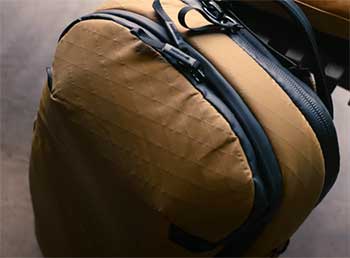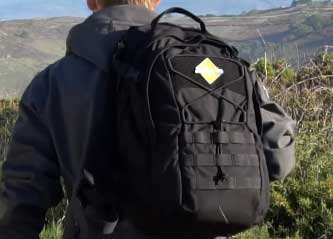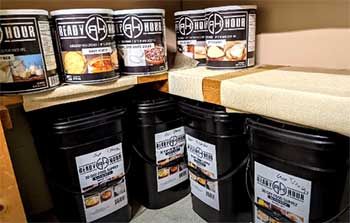In the battle of durable, resilient materials for your perfect backpack, two names often surface: X-Pac and Cordura. Both materials have earned significant respect in the outdoor gear industry, owing to their distinct features and robustness.
But when choosing between X-Pac and Cordura backpacks, which one should you choose?
Let’s dive into this and find out.
A Brief Comparison Table
| Characteristics | X-Pac | Cordura |
| Material Composition | Multi-layer laminate material (nylon face, X-Ply mesh, waterproof film) | High-strength nylon fabric |
| Weight | Lightweight | Heavier |
| Waterproofing | Excellent (waterproof) | Good (water-resistant, can be improved with DWR or rain covers) |
| Durability | Very durable (good tear strength and abrasion resistance) | Extremely durable (excellent abrasion, tear, and scuff resistance) |
| Aesthetics | Modern, distinctive X-Ply pattern | Classic, rugged look |
| Noise | Can be crinkly and noisy | Quiet |
| Color Variety | Limited | Wide range |
| Price | Generally higher | More affordable, varies with type and weight of fabric |
X-Pac Backpacks: The Lightweight Powerhouse

X-Pac is a composite fabric, developed by the sailcloth experts at Dimension-Polyant.
Its crosshatching laminate design enhances its strength while keeping the weight to a minimum.
So yes, to answer one of the most frequently asked questions, X-Pac is indeed lighter than Cordura, making it a desirable option for outdoor enthusiasts concerned about weight.
Pros of X-Pac Backpacks
- Lightweight: One of the key advantages of X-Pac backpacks is their lighter weight compared to many other material backpacks, including Cordura. If you’re into long-distance hiking or ultralight backpacking, X-Pac might be your material of choice.
- Water-Resistant: X-Pac is inherently water-resistant, thanks to its laminate layers, making it an excellent choice for activities in moist conditions.
- Durability: X-Pac’s unique layered structure contributes to its durability, giving it the ability to withstand a variety of harsh conditions.
Cons of X-Pac Backpacks
- Cost: X-Pac is a premium material, and backpacks made from it tend to be more expensive than those made from other materials, including Cordura.
- Noise: Due to its stiff texture, X-Pac can be relatively noisy, which might not be appealing if you’re seeking a silent glide through nature.
- Limited Color Options: X-Pac isn’t available in as many colors as some other materials, which might be a downside if you prefer vibrant hues.
Also Read: Differences Between JanSport And L.L.Bean Backpacks.
Cordura Backpacks: The Battle-Tested Behemoth
Cordura, a brand-name for a collection of fabrics used in a wide variety of products, including luggage, boots, and performance apparel, is known for its durability and resistance to abrasions, tears, and scuffs.
It’s one of the most trusted materials in the backpack industry.
Pros of Cordura Backpacks
- Extreme Durability: Cordura’s standout feature is its immense durability. It’s incredibly tough and can withstand a lot of abuse, making it perfect for heavy-duty applications.
- Versatility: Cordura is available in different weights and finishes, providing a range of options to suit various needs.
- Color Variety: Cordura comes in a broader range of colors than X-Pac, offering more aesthetic choices.
Cons of Cordura Backpacks
- Weight: Cordura tends to be heavier than X-Pac, making it a less appealing choice if weight is a concern.
- Moisture Absorption: While Cordura is water-resistant, it isn’t as waterproof as X-Pac. It can absorb moisture and take a while to dry out.
- Abrasion on Clothing: Cordura’s rough texture can cause wear and tear on clothing over time.
Key Differences Between X-Pac And Cordura Backpacks
Let’s take a closer look at the key differences between X-Pac and Cordura backpacks. There are a handful of differences to consider, and understanding these can significantly help in making the right choice for your backpacking needs.
- Material Composition
X-Pac and Cordura have vastly different material compositions, which define their distinct characteristics.

X-Pac is a multi-layer laminate material, typically composed of a nylon face fabric for abrasion resistance, a polyester X-Ply mesh for bias stability and tear strength, and a waterproof film to keep moisture at bay.
These layers combined deliver a lightweight yet robust fabric ideal for demanding environments.
On the other hand, Cordura is made from high-strength nylon fabric.
The material’s durability comes from the air-textured, high tenacity nylon fibers used in its construction. The Cordura fabric is known for its long-lasting durability and resistance to abrasions, tears, and scuffs.
- Weight and Comfort
When it comes to weight, X-Pac backpacks often have the upper hand. X-Pac’s structure allows for high strength-to-weight ratios. Its lightweight nature can make a significant difference in activities such as long-distance hiking and backpacking where every ounce matters.
Conversely, Cordura backpacks tend to be heavier due to their dense, robust fabric. However, their weight can sometimes translate into a more structured, often more comfortable carry, especially when packing heavy loads. Some users prefer the feel of Cordura backpacks as they can maintain their shape better.
- Waterproofing
Another critical difference lies in the water-resistant properties of the materials. X-Pac, thanks to its waterproof film layer, is more waterproof than Cordura.
It performs exceptionally well in wet environments and doesn’t absorb water, so it doesn’t gain extra weight when exposed to rain or moisture.
Cordura, while water-resistant, isn’t as waterproof as X-Pac. It can absorb water and may become heavier and take longer to dry in wet conditions. However, many Cordura backpacks feature a durable water repellent (DWR) coating or come with rain covers to improve their water resistance.
- Aesthetics and Noise
X-Pac backpacks, with their sailcloth appearance and unique X-Ply pattern, offer a distinct, modern aesthetic. However, one downside is that X-Pac can be quite crinkly and noisy, which some users might find disturbing.
Cordura backpacks offer a classic, rugged look with a softer, fabric-like feel. They are available in a wider range of colors than X-Pac backpacks and are much quieter when moving around.
- Price
Finally, price is an important consideration. X-Pac backpacks tend to be pricier due to the high cost of the fabric. Its lightweight, high-strength, and water-resistant properties come at a premium.
In contrast, Cordura backpacks are generally more affordable. However, the price can vary depending on the specific type and weight of the Cordura fabric used.
Also Read: Differences Between Robic And Dyneema Packs.
Frequently Asked Questions (FAQ)
Yes, X-Pac is typically lighter than Cordura. This lighter weight makes it an excellent choice for long-distance hiking and ultralight backpacking.
Yes, X-Pac material is highly regarded. It’s lightweight, water-resistant, and durable, making it a great choice for outdoor gear, particularly backpacks.
There are several substitutes for Cordura, including nylon, polyester, and natural fibers like cotton or canvas. Each has its unique benefits and drawbacks.
X-Pac is a laminate fabric created by Dimension-Polyant. It features a unique crosshatch design which gives it its strength and lightweight properties.
Final Thoughts
In conclusion, both X-Pac and Cordura backpacks have their unique strengths and weaknesses. X-Pac may be the go-to for lightweight, water-resistant backpacks, while Cordura could be your top pick for extreme durability and versatility.
It all boils down to what features you value the most in your backpack. Happy backpack hunting!

